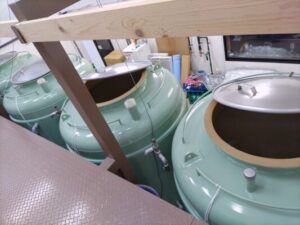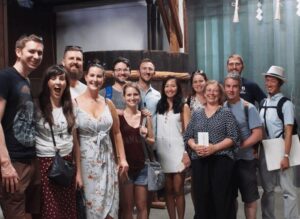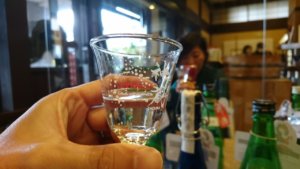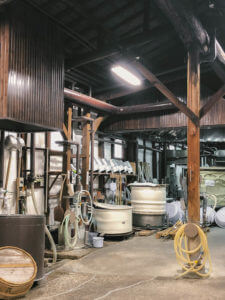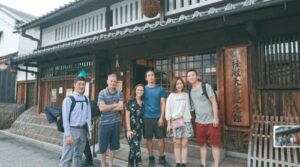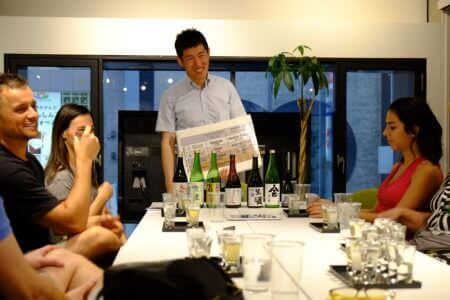Fushimi Kyoto, Home for Sake
When you think of Kyoto, what do you think of? …temples, shrines, maiko (apprentice geisha)…the list goes on and on.
But did you know that Kyoto is actually one of Japan’s most famous cities for sake?
Fushimi, in the south of Kyoto, is home to more than 20 sake breweries and is one of the three most famous sake breweries in Japan. This time we went to visit one of these breweries, the Fujioka Sake Brewery!
Fujioka Sake Brewery, Established in 1902
Fujioka Sake Brewery is located in the middle of Fushimi, a 5 minute walk from Fushimi Momoyama station. They started brewing sake in 1902 in Higashiyama-ku, Kyoto.
Later, they added a manufacturing plant in Otsu City, Shiga Prefecture, and in 1910, they established a brewery in Fushimi, and in 1918, they started production at their current location. At its peak, the brewery was producing around 8,000 koku of sake, but the sudden death of the third generation brewer in 1994 led to the closure of the brewery in 1995.
After that, the current brewer, Masaaki Fujioka, the fifth generation head of the family, could not forget his passion for sake brewing and rebuilt the brewery in 2002, starting from scratch.
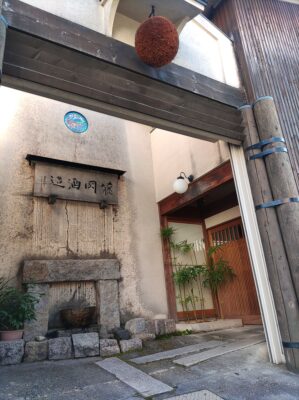
Explore Brewery’s Bar En
The tour of the Fujioka Sake Brewery starts at the “Sake Bar En” (Fujioka Sake Brewery’s sake tasting and sales space). The tour begins with an exciting climb up the external stairs to the first floor of the Bar En.
The room has a clean and welcoming atmosphere. In the middle of the room there is a desk with a big wooden box and a glass… In the box there are many fashionable empty bottles and white cloth bags. I know that I have seen this kind of box before…
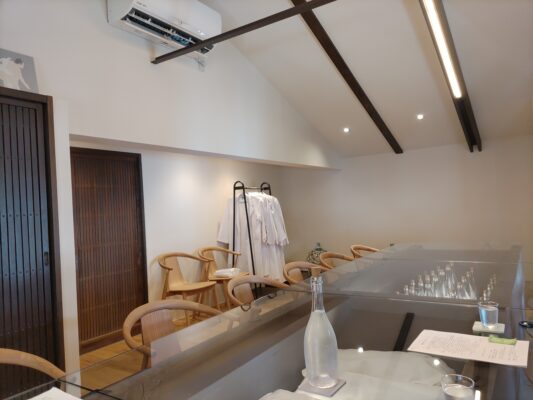
While we were taking a look at the desk and the empty bottles, Masaaki Fujioka, the fifth generation brewer, appeared. My first impression of him was that he was polite, soft and easy to talk to. When I asked him about the desk, he said, “This is the tank we used to use in the past. I remembered that there was a drip hole at the end of the desk!
I’ve seen the tank on display a few times, but this is the first time I’ve seen it so closely.It’s a lovely reuse of something that was used in the past, and I was very impressed.
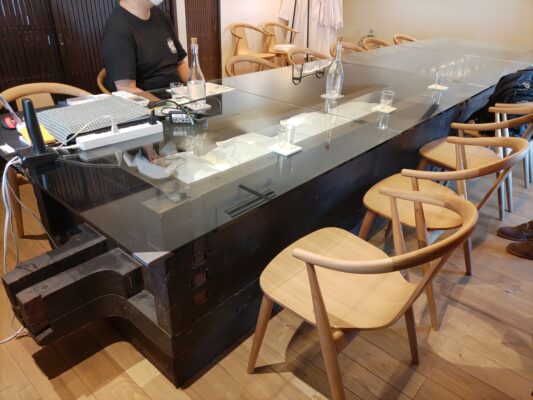
Interview – Brewer’s Passion and Thoughts on Sake
We were able to talk to Masaaki Fujioka about the history of the Fujioka Sake Brewery, the sake rice and his passion for sake making. By the way, the water we were served here is the brewing water of the Fujioka Brewery!
The newly rebuilt red brick brewery is the original Fujioka Sake Brewery warehouse and is the smallest brewery in Fushimi with only 6 brewing tanks. When he decided to start a new brand of sake, focusing on Junmai sake instead of many different types.
The concept of the new brand is “a feeling of relief when you look up at the blue sky”. The Fujioka Sake Brewery’s brand “Sokuu” was named after this idea.
Commitment to Sake Brewing
In Pursuit of the Ideal Water
Mr Fujioka’s passion for making sake has led him to use only rice and water as raw materials, and to produce even ordinary sake with the same care and attention to detail as Daiginjo sake. A typical sake brewery would make one bottle a day, but at Fujioka Shuzo they only make one bottle a week!
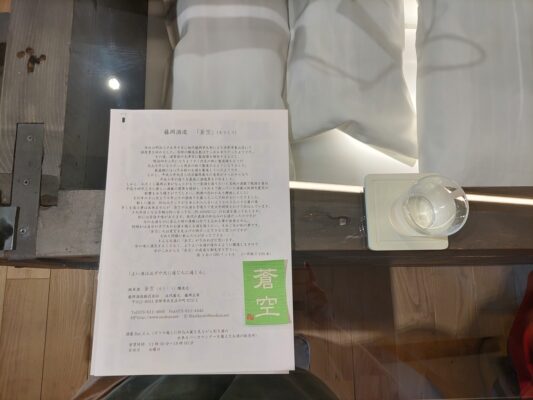
Not only the process, but also the water and the rice are of course very important. Fushimi, where Fujioka Sake Brewery is located, is a place where good quality underground water called “Fushimizu” used to flow. Wherever you dig in Fushimi, you will find good well water.
Shiragikusui(白菊水)water, which is said to be the best underground water of them all, flows from east to west. Fujioka Sake Brewery, located in the most eastern part of Fushimi, uses the best well water from the upper reaches of the Shiragikusui Water for its sake brewing.
In Pursuit of the Ideal Rice
Fujioka Sake Brewery is also very particular about another ingredient, the rice. The main sake rice used nowadays is Yamada Nishiki from Hyogo Prefecture for Ginjo sake and Miyamanishiki from Nagano Prefecture for Junmai sake.
Until a few years ago, Yamada-Nishiki was the main rice used, but one year, due to typhoon damage, it was difficult to obtain the main rice.
Then he remembered Miyamanishiki from Nagano prefecture, which is often used for sake brewing in the Kanto region, and tried to brew sake with it.
He was very much surprised to find that the Junmai-shu made with Miyamanishiki tasted exactly as he had hoped. Today, Miyamanishiki is one of the main rice used for sake production.
The Fujioka Sake Brewery’s commitment to rice continues. When he went to visit a winery to improve his skills, he was struck by the strong attention to the soil in which the grapes were grown.
Growing Own Rice for Sake
He then reflected on his own passion for rice and felt that it was essential to learn more about it. To do this, he put his own feet into the rice fields, planted the seedlings by hand, pulled out the weeds and worked up a sweat. He wanted to learn about the soil, the rice and the brewing process through such hard work, which is why he decided to start growing his own rice.
After several years of searching for the ideal land for growing rice, he finally decided to start growing rice in Ohara, Kyoto.
Kyoto Ohara is located in the north-east of the city of Kyoto, between mountains on the east and west and a river running from north to south.It is a land so rich in nature that deer, wild boar and even moles appear, and he uses the abundant water from the mountains to grow his rice.
Fighting the moles is an important part of the rice cultivation process, as he has to find holes in the rice and plug them to prevent the water from draining out.
Kinuhikari
The kind of rice that Mr Fujioka grows is called Kinuhikari. It is the most widely grown and popular rice in Ohara, Kyoto.
The sake made from this rice is also sold at the Fujioka Brewery. They think that in the future it will be difficult to make sake from sake rice alone, so they are also working hard to improve their techniques for making sake from regular rice like Kinuhikari.
It is a land so rich in nature that deer, wild boar and even moles appear, and he uses the abundant water from the mountains to grow his rice.
Fighting the moles is an important part of the rice cultivation process, as he has to find holes in the rice and plug them to prevent the water from draining out.
Never Stop being Curious
In addition, unlike conventional sake brewing, they don’t just polish the rice, but also use the parts that have been cut off, and try to find ways to make the most of the miscellaneous flavours.
He said he would like to try his hand at brewing sake with lower polished rice in the future.
As you can see, the brewer’s inquisitive mind is important to him, and he is very focused on the quality of his sake.
After listening to a lot of stories, we went to visit the brewery. To be continued in the next article “Fujioka Sake Brewery Tour 2: Learn about the lovingly crafted process of making sake”!
Fujioka Shuzo Sake Brewery
Bar En Opening Hour : 11:30~18:00 | Close Wednesday
Require booking for sake brewery tour. Check Website for details http://www.sookuu.net/



